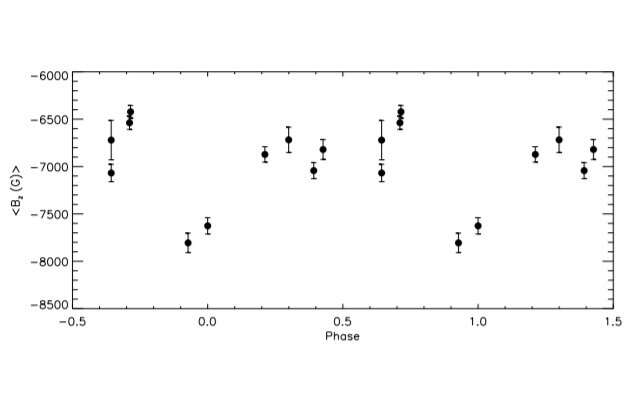November 1, 2021 report
HD 144941 is the most extreme helium-strong star, observations reveal

Astronomers from Austria and Northern Ireland have inspected a peculiar extreme helium supergiant star known as HD 144941. Results of the new study, published October 21 on the arXiv pre-print server, indicate that HD 144941 is the most extreme helium-strong star so far detected.
The so-called extreme helium (EHe) stars are a very rare class of low-mass hydrogen-deficient stars. Studies show that they are supergiant stars almost devoid of hydrogen and are assumed to be the product of the mergers of helium-core and carbon-oxygen core white dwarfs.
At a distance of some 5,100 light years, HD 144941 is an EHe star initially detected about a half-century ago. The object has a radius of some 3.8 solar radii and is about eight times more massive than the sun. The star has a rotational period of 13.9 days and its effective temperature is estimated to be 22,000 K.
Previous observations of HD 144941 have shown its peculiarity among the known EHe stars. It was found that this star has a comparatively high gravity, an unusually high hydrogen abundance of about 5 percent, and a metallicity of 1.6 dex below solar. The measured chemical abundances are not showing the products of any nuclear reactions other than hydrogen burning. However, yet, HD 144941 appears to showcase properties much closer to those of the EHe stars than to those of any other helium-rich stars.
So a team of astronomers led by Norbert Przybilla of the University of Innsbruck, Austria, further investigated the true nature of HD 144941. Their study is based mainly on the data acquired with FOcal Reducer and low dispersion Spectrograph 2 (FORS2) low-resolution spectropolarimeter attached to the European Southern Observatory (ESO) Very Large Telescope (VLT) Unit Telescope 1 (UT1) at Cerro Paranal, Chile.
"We discuss the first spectropolarimetric observations of the star and perform a quantitative spectral reanalysis, which show that HD 144941 is indeed a very different type of star than supposed to date," the researchers wrote in the paper.
The observations of HD 144941 detected a strong longitudinal magnetic field with surface-averaged longitudinal field strengths at a level of 9 kG. The study also identified Zeeman splitting of spectral lines to a field strength of at least 15 kG. This, according to the authors of the research, explains the recent finding of surface spots of this star.
The metal abundances obtained for HD 144941 turned out to be about a factor four higher than in previous determinations, but they are still rather low—about a factor of 10 sub-solar in absolute number.
According to the study, carbon abundance is in contrast to the typical EHe stars where the carbon number fraction is of the order of 1 percent (about 50 times solar). Nitrogen was found to be slightly enriched relative to carbon and oxygen. When it comes to some alpha-elements like neon or sulfur, they appear to be overabundant with respect to iron.
The astronomers suggest that taking into account all the new results, HD 144941 is a helium-stron star—a main-sequence B star in which atmospheric hydrogen and metals have been substantially depleted by a fractionated stellar wind.
"The canonical mechanism for producing the helium enrichment of the atmospheric layers of He-strong stars via a weak, fractionated stellar wind in the presence of a magnetic field could indeed lead to the observed pattern in absolute numbers," they explained.
The researchers noted that HD144941 appears to be the most extreme member of the class of helium-strong stars. They added that this star is unique with regard to helium content in the visible hemisphere, with almost all of the atmospheric hydrogen substituted by helium.
More information: N. Przybilla, L. Fossati, C.S. Jeffery, HD144941: The most extreme helium-strong star. arXiv:2110.11267v1 [astro-ph.SR], arxiv.org/abs/2110.11267
© 2021 Science X Network





















